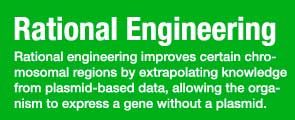| | Chassis engineering or strain engineering focuses on the modification of chromosomes instead of plasmids and encompasses both <a href="https://2012.igem.org/Team:UC_Davis/Project/Our_Strain">directed evolution</a> | | Chassis engineering or strain engineering focuses on the modification of chromosomes instead of plasmids and encompasses both <a href="https://2012.igem.org/Team:UC_Davis/Project/Our_Strain">directed evolution</a> |
| - | and <a href="https://2012.igem.org/Team:UC_Davis/Project/Our_Strain">rational engineering</a>. This part of the project focuses on the degradation of ethylene glycol, a degradation product of PET that is metabolized to oxalic acid further downstream the metabolic pathway. Oxalic acid is toxic to the kidney and fatal to the organism. (For a look at how we handled these compounds safely, look at our <a href="https://2012.igem.org/Team:UC_Davis/Safety">Safety Page</a>!) | + | and <a href="https://2012.igem.org/Team:UC_Davis/Project/Our_Strain">rational engineering</a>. This part of the project focuses on the elimination of ethylene glycol, a degradation product of PET that is metabolized to oxalic acid further downstream the metabolic pathway. Oxalic acid is toxic to the kidney and fatal to the organism (2). (For a look at how we handled these compounds safely, look at our <a href="https://2012.igem.org/Team:UC_Davis/Safety">Safety Page</a>!) |
| - | Once we discovered the potential toxicity of our project, we searched high and low to find ways to eliminate ethylene glycol (EG) as much as possible. In the scientific literature, we found an <I>E. coli</I> mutant, called Strain E-15 EG3, from the University of Barcelona, that is able to grow on ethylene glycol alone [1].E-15 EG3, which is originally derived from MG1655, was created through directed evolution, a process that selects for the most fit in a population. Then, the scientists performed ethyl methylsulfonate (EMS) on the cultures, plated the cells on media with ethylene glycol, and restreaked the colonies several times. | + | Once we discovered the potential toxicity of our project, we searched high and low to find ways to eliminate ethylene glycol (EG) as much as possible. In the scientific literature, we found an <I>E. coli</I> mutant, called Strain E-15 EG3, from the University of Barcelona, that is able to grow on ethylene glycol alone (1). E-15 EG3, which is originally derived from MG1655, was created through directed evolution, a process that selects for the most fit in a population. Then, the scientists performed ethyl methylsulfonate (EMS) on the cultures, plated the cells on media with ethylene glycol, and restreaked the colonies several times. |
| | <br><br>From this, they learned that the main contributors in the degradation were propanediol oxidoreductase and glycolaldehyde dehydrogenase. These two enzymes are expressed at low levels in MG1655 but not at all in DH5α. We want to overexpress these enzymes in MG1655 through directed strain engineering. Rather than take the enzymes from Strain E-15 EG3, we want to clone the enzymes from the MG1655 and be able to control them ourselves, also known as rational strain engineering. | | <br><br>From this, they learned that the main contributors in the degradation were propanediol oxidoreductase and glycolaldehyde dehydrogenase. These two enzymes are expressed at low levels in MG1655 but not at all in DH5α. We want to overexpress these enzymes in MG1655 through directed strain engineering. Rather than take the enzymes from Strain E-15 EG3, we want to clone the enzymes from the MG1655 and be able to control them ourselves, also known as rational strain engineering. |

 "
"






















